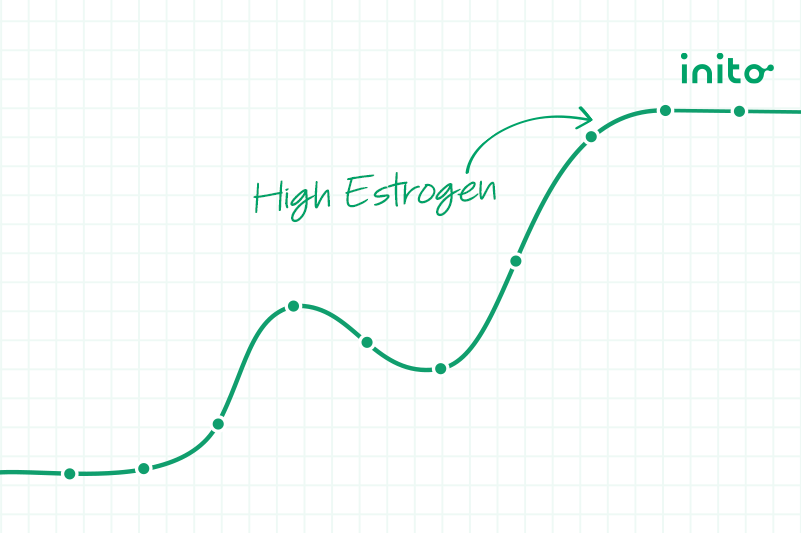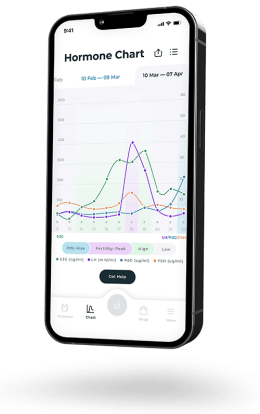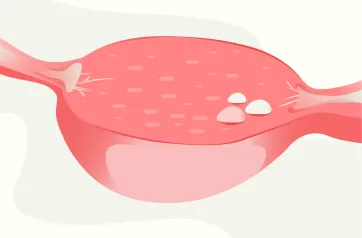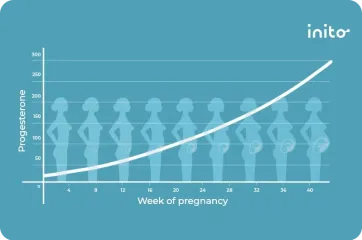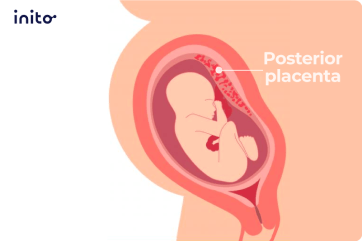Content table
For many of us, the last time we learned about estrogen was in high school biology.
To quickly refresh your memory, estrogen plays many vital roles in the female body. It regulates reproductive, cognitive, cardiovascular, and bone health, among other bodily processes.
But sometimes, estrogen levels become too high compared to progesterone. This is a condition known as estrogen dominance.
But sometimes, estrogen levels become too high as compared to progesterone. This is a condition known as estrogen dominance.
So why does it matter if you have too much estrogen?
Like all hormones in the body, estrogen levels must remain balanced. Deviating too far from the norm can have adverse effects on your health and fertility.
Think of it like a seesaw. It must be perfectly balanced on both ends for it to work properly!
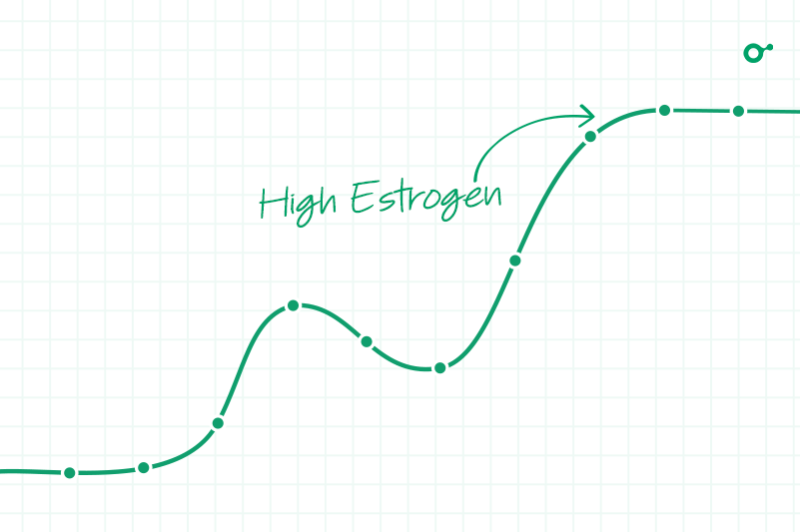
In this article, we’re diving deep into the subject of estrogen dominance in women. We’ll explain what it is, how it affects the menstrual cycle and fertility, and what causes it. Additionally, we’ll provide tips on how to help manage your estrogen levels.
Key Takeaways
- Estrogen levels rise and fall twice during the menstrual cycle. The first rise is during the follicular phase, followed by a drop after ovulation. They then rise again during the luteal phase and decrease at the end of the menstrual cycle.
- Estrogen dominance is when estrogen levels are high in comparison to progesterone levels. This can have several negative impacts on health.
- Estrogen dominance may arise due to an overproduction of estrogen by the body or changes in estrogen breakdown and excretion. This results in an imbalance in the estrogen-to-progesterone ratio. Several lifestyle factors may influence this.
- High estrogen levels in the follicular phase can prevent ovulation. In the luteal phase, they can prevent the lining of the womb from developing properly. High estrogen also reduces the chances of an embryo implanting successfully.
- Tests that measure estrogen levels can help identify estrogen dominance. You may also experience a number of estrogen-dominance symptoms.
- It is still possible to get pregnant with estrogen dominance. Although, it is much more difficult. Tracking your fertile days can help identify the times you are most likely to conceive.
- Making simple lifestyle changes can help balance estrogen levels. These might include maintaining a healthy weight, altering your diet, and taking supplements.
- If you think you have estrogen dominance, consult with your doctor so you can seek treatment.
A Normal Estrogen Pattern
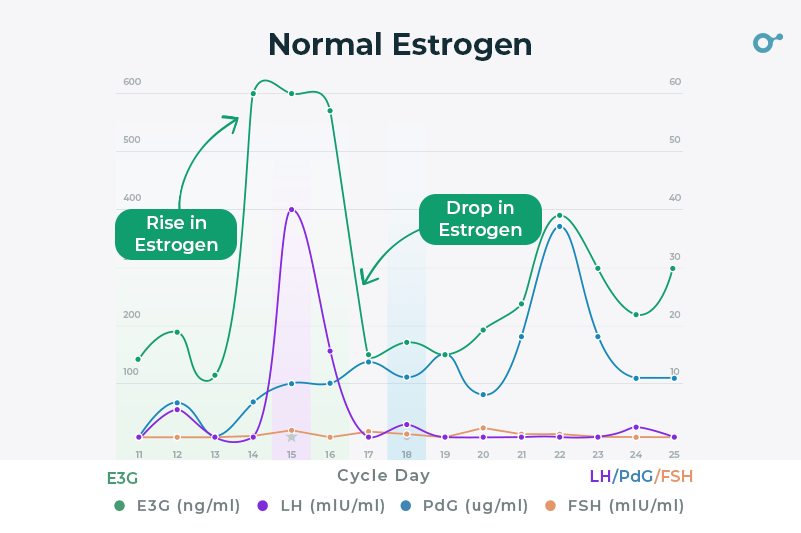
Throughout a regular menstrual cycle, estrogen levels naturally fluctuate. This triggers ovulation and prepares the womb for pregnancy.
There are three main phases of the menstrual cycle:
Follicular phase
The follicular phase begins on the first day of your period and lasts until you ovulate. During this time, estrogen levels are relatively low.
In this phase, the pituitary gland releases Follicle-Stimulating Hormone (FSH), which stimulates your ovaries to produce follicles. These fluid-filled sacs hold an immature egg.
Typically, only one follicle matures. As it grows, it releases estrogen. This causes the lining of the uterus to thicken, creating a perfect spongy environment for implantation.
Ovulation
Rising estrogen levels stimulate the release of Luteinizing Hormone (LH) from the pituitary gland. As LH surges, it triggers ovulation. Once an egg is released from the ovary, estrogen levels drop dramatically.
Luteal phase
After an egg has left the follicle, it forms a structure known as the corpus luteum. The corpus luteum releases progesterone to maintain a thick uterine lining.
If the egg is not fertilized, the corpus luteum is reabsorbed by the body. This causes progesterone levels to decline along with estrogen, triggering the start of your period.
What Is Estrogen Dominance in Women?
Estrogen dominance is a condition characterized by high estrogen levels compared to progesterone. This means there is little counterbalancing against the effects of estrogen.
Usually, estrogen and progesterone work together in harmony. One of their main jobs is regulating the menstrual cycle and reproduction.
Estrogen is a pro-growth hormone. It stimulates cell division and tissue growth. For example, it promotes the development of the uterine lining, supports the maturation of the follicle in the ovary, and is responsible for the formation of breasts.
Progesterone works as an antagonist to keep the growth effects of estrogen in check.
But sometimes, the delicate interplay between these two hormones becomes imbalanced. This throws things a bit out of whack and can cause your health to suffer.
As a result, estrogen dominance can cause significant disruptions to the menstrual cycle.
If left untreated, it may increase the risk of breast cancer, fibroids, endometriosis, and polycystic ovary syndrome (PCOS).
What Are the Causes of Estrogen Dominance?
Estrogen dominance may arise due to an overproduction of estrogen or changes in how the body breaks down or removes estrogen. This causes an imbalance in the estrogen-to-progesterone ratio.
While sometimes estrogen dominance develops naturally, lifestyle factors can also contribute. These include:
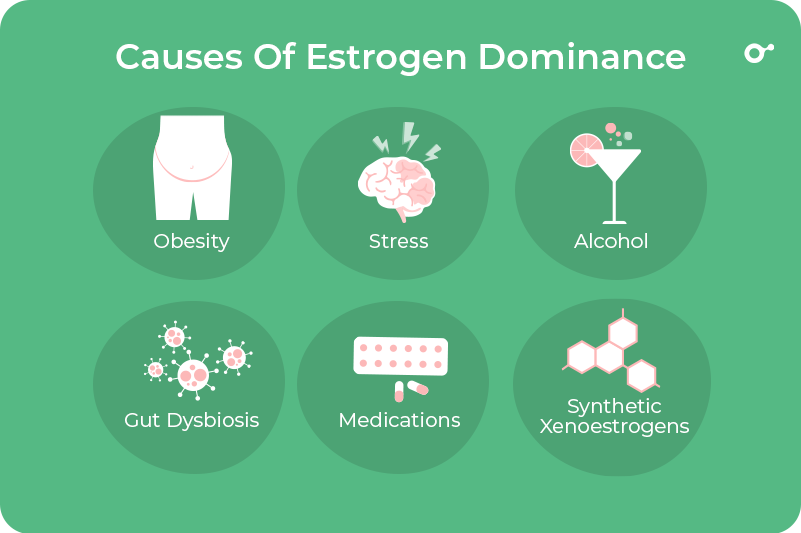
- Obesity: Estrogen is produced and stored in your body’s fat tissue. The more excess fat you’re carrying, the more estrogen will be circulating.
- Stress: When you’re stressed, your body’s demands for cortisol increase. This can cause your body to use progesterone to make more cortisol, which can throw off your estrogen-to-progesterone ratio.
- Alcohol: Your liver breaks down excess hormones, including estrogen. But it can’t do its job effectively if you’re drinking an excessive amount of alcohol. This can cause estrogen levels to rise.
- Gut dysbiosis: If your gut is harboring too many harmful species of bacteria, it can overburden the liver. This makes it more difficult for the liver to remove excess estrogen.
- Medications: The contraceptive pill or hormone replacement therapy may increase estrogen levels.
- Synthetic xenoestrogens: Certain chemicals mimic the way estrogen acts in the body. These include bisphenol A (BPA) and phthalates, which are found in plastics and personal care products.
How Does Estrogen Dominance Affect the Follicular and Luteal Phases?
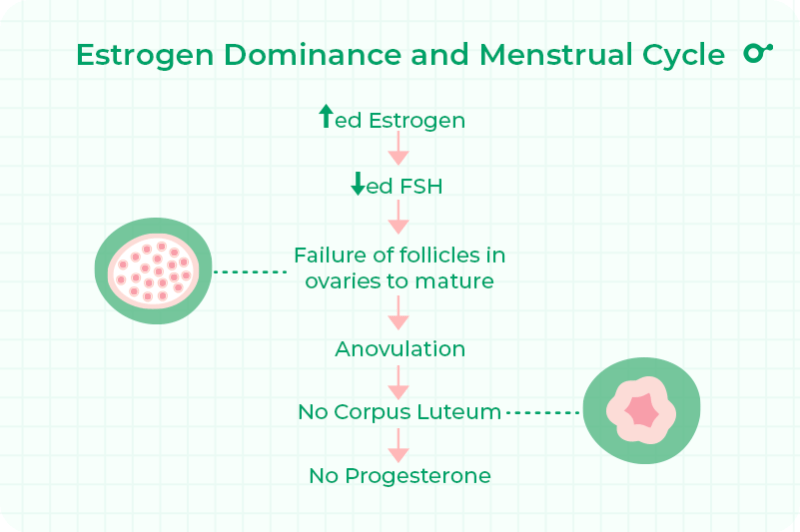
Estrogen dominance may affect hormone release during the follicular phase, potentially preventing ovulation.
According to one study, women who took estrogen had reduced responsiveness to gonadotropin-releasing hormone (GnRH), which stimulates the release of FSH. This caused FSH levels to decline.
Without enough FSH, follicles in the ovaries may not mature, and an egg may not be released. This is known as anovulation and it’s responsible for around 30% of all cases of female infertility.
Anovulatory cycles can contribute to the progesterone-to-estrogen imbalance. Without ovulation, the corpus luteum will not form in the luteal phase.
The corpus luteum’s main job is to produce progesterone. Without the corpus luteum, progesterone drops. This prevents the uterine lining from developing properly, which hinders fertility.
Low progesterone in the luteal phase may also lead to more severe premenstrual symptoms, such as low moods and breast tenderness.
How Can I Identify Estrogen Dominance?
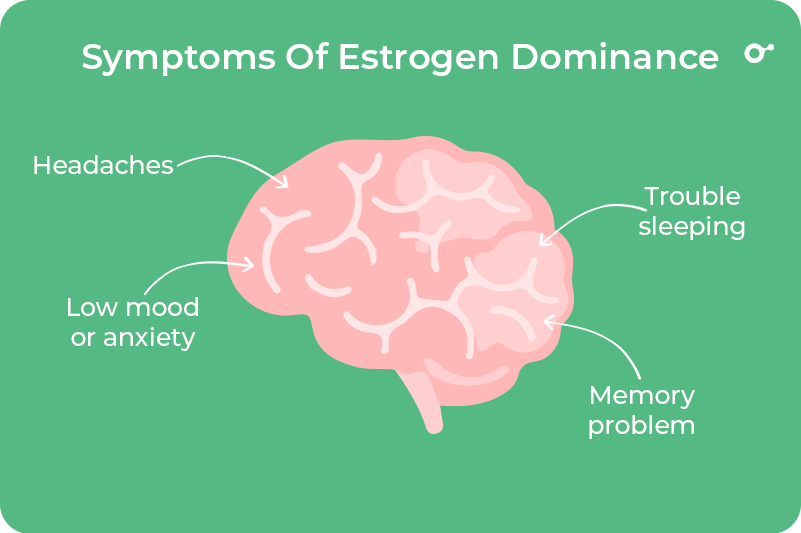
High estrogen levels can have noticeable effects on the body. But because every woman is wonderfully unique, the type and severity of estrogen dominance symptoms may differ.
Here are some common symptoms of estrogen dominance in women to look out for:
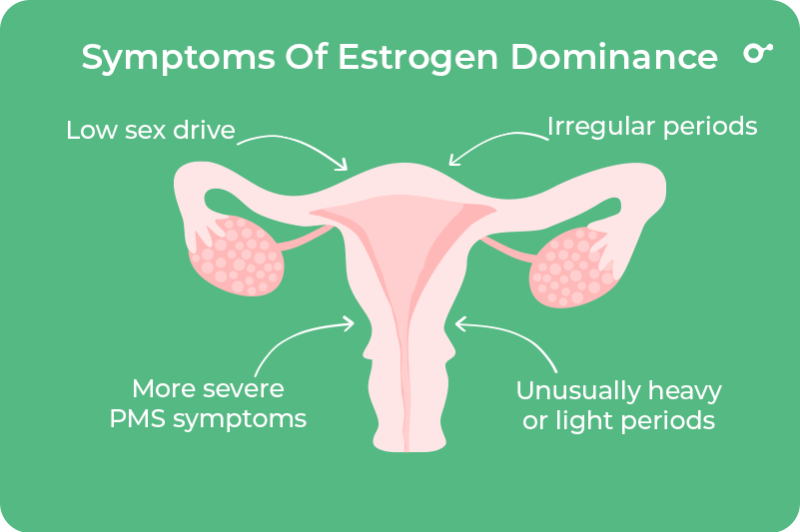
- Fatigue
- Unusually heavy or light periods
- Irregular periods
- Weight gain
- More severe PMS symptoms
- Low sex drive
- Low mood or anxiety
- Bloating
- Swollen or tender breasts
- Fibrocystic lumps in your breasts
- Headaches
- Hair loss
- Trouble sleeping
- Memory problems
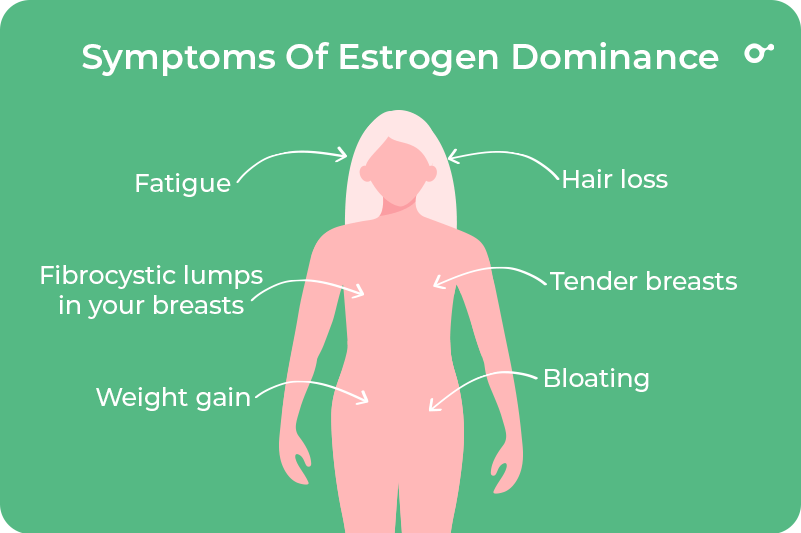
If you experience any of the above symptoms and are worried you have high estrogen, taking an estrogen test can help identify imbalances. These generally use blood, saliva, or urine to measure hormone levels in the body.
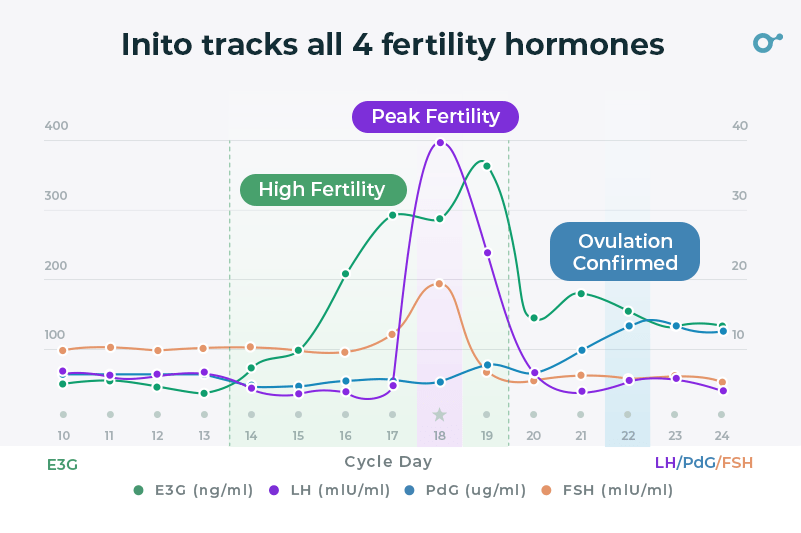
A professional can conduct tests for diagnosing estrogen dominance. These include measuring the estrogen-to-progesterone ratio.
Can I Get Pregnant With Estrogen Dominance?
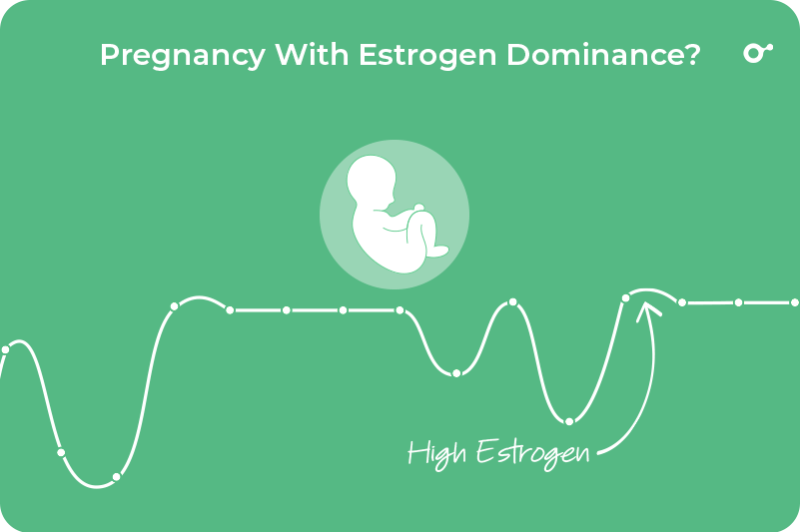
It’s possible – but more challenging.
As mentioned, estrogen dominance in the follicular phase can cause anovulatory cycles. Without the release of an egg, it’s not possible to conceive.
And without ovulation, there’s no empty follicle to produce progesterone. Your body needs progesterone to maintain a healthy pregnancy and reduce the likelihood of miscarriage.
High estrogen also throws off the estrogen-to-progesterone ratio. Both of these hormones influence the implantation window and the uterus’s receptivity to an embryo. When they’re imbalanced, it can harm fertility.
But the good news is, it is possible to get pregnant with estrogen dominance! Keep reading to learn how to lower your estrogen levels and increase your chances of pregnancy.
How to Calculate My Fertile Window With Estrogen Dominance?
Your fertile window is the four days leading up to ovulation, the day of ovulation, and the day after. Having sex during these days offers the best chance of pregnancy.
But how do you predict your most fertile days?
With estrogen dominance, tracking your fertile window can be tricky. Your fertile window is determined by rising estrogen levels 3-4 days before ovulation. In estrogen dominance, your estrogen levels are high from the get, resulting in confusion.
A fertility monitor, such as the Inito Fertility Monitor, allows you to predict your fertile window accurately. It detects the rising estrogen levels in the follicular phase prior to ovulation. Understanding your cycle provides a clearer picture of your hormones, increasing your chances of conception.
And unlike many ovulation tests that are based on thresholds, Inito measures your actual hormone values. This gives you clear insights into your estrogen levels and how they compare to progesterone.
How to Manage Estrogen Dominance?
The best estrogen dominance treatment depends on the cause of your high estrogen levels. Sometimes, making some simple lifestyle changes can help lower them. Essentially, the healthier you are, the better!
According to research, the following are proven to help:
- Maintaining a healthy weight
- Eating a vegetarian diet
- Eating isoflavones such as soy and flaxseeds
- Eating cruciferous vegetables such as broccoli and kale
- Increase fiber intake
- Regular exercise
- Anti-inflammatory supplements such as ginger and turmeric
- Liver support supplements such as milk thistle
- Increasing intake of omega-3 fatty acids
- Reducing stress
- Reducing alcohol consumption
- Avoiding xenoestrogens (swap plastic food containers for glass)
Your doctor can also help you manage your estrogen levels. If your estrogen dominance is a result of the prescription hormones you are taking, these may be adjusted.
Or, if there is a risk of more serious health complications, such as cancer, you might be prescribed medication. Estrogen dominance treatment with medication may include:
- Aromatase inhibitors: prevent fat cells from producing estrogen and are used to help treat breast cancer.
- Gonadotropin-releasing hormone (GnRH) agonists: prevent your ovaries from releasing estrogen.
When Should I Consult My Doctor?
If you suspect you have estrogen dominance, you’ll want to consult your doctor as soon as possible, primarily because it’s important to understand what’s causing high estrogen in your body. This can help ensure you receive appropriate treatment.
Was this article helpful?
- Estrogen: The necessary evil for human health, and ways to tame it
- The Effects of Diet and Exercise on Endogenous Estrogens and Subsequent Breast Cancer Risk in Postmenopausal Women – PMC
- Estrogen – StatPearls – NCBI Bookshelf
- Effect of estrogens on skin aging and the potential role of SERMs – PMC
- Estrogen’s Effects on the Female Body | Johns Hopkins Medicine
- Estrogen Dominance – Whole Health Library.
- Estrogen Negative Feedback on Gonadotropin Secretion: Evidence for a Direct Pituitary Effect in Women
- Estrogen inhibits luteinizing hormone (LH), but not follicle-stimulating hormone secretion in hypophysectomized pituitary-grafted rats receiving pulsatile LH-releasing hormone infusions
- Chronic progesterone antagonist–estradiol therapy suppresses breakthrough bleeding and endometrial proliferation in a menopausal macaque model | Human Reproduction | Oxford Academic
- The Normal Menstrual Cycle and the Control of Ovulation – Endotext – NCBI Bookshelf
- Low Luteal Serum Progesterone Levels Are Associated With Lower Ongoing Pregnancy and Live Birth Rates in ART: Systematic Review and Meta-Analyses – PMC
- estrogen | hormone | Britannica
- Low Luteal Serum Progesterone Levels Are Associated With Lower Ongoing Pregnancy and Live Birth Rates in ART: Systematic Review and Meta-Analyses – PMC
- Estrogen Affects IVF Success
- Lowered Plasma Steady-State Levels of Progesterone Combined With Declining Progesterone Levels During the Luteal Phase Predict Peri-Menstrual Syndrome and Its Major Subdomains




